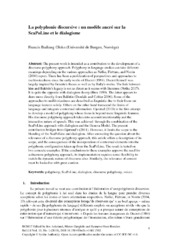| dc.contributor.author | Badiang Oloko, Francis | |
| dc.date.accessioned | 2020-04-26T19:10:53Z | |
| dc.date.available | 2020-04-26T19:10:53Z | |
| dc.date.issued | 2019-11-14 | |
| dc.Published | Badiang Oloko FB. La polyphonie discursive: un modèle ancré sur la ScaPoLine et le dialogisme. Bergen Language and Linguistics Studies (BeLLS). 2019;10(1) | eng |
| dc.identifier.issn | 1892-2449 | |
| dc.identifier.uri | https://hdl.handle.net/1956/22007 | |
| dc.description.abstract | The present work is intended as a contribution to the development of a discourse polyphony approach. Polyphony in language studies can take different meanings depending on the various approaches as Nølke, Fløttum, and Norén (2004) report. There has been a proliferation of perspectives and approaches to multivoicedness since the early works of Ducrot (1984). Ducrot himself was largely inspired by Genette's theses as well as by Bally's works. The link between him and Bakhtin's legacy is not as direct as it seems with literature (Nølke 2017). It is quite the opposite with dialogism theory (Bres 1999). The latter appears to draw more directly from Bakhtin (Dendale and Coltier 2006). Some of the approaches to multivoicedness are described as linguistic due to their focus on language features solely. Others on the other hand transcend the limits of language and integrate contextual information. Gjerstad (2011) is the first attempt to develop a model of polyphony whose focus is beyond mere linguistic features. His discourse polyphony approach takes into account intentionality and the interactive nature of speech. This was achieved through the combination of the ScaPoLine approach with dialogism and the Geneva Model. The present contribution bridges from Gjerstad’s (2011). However, it limits the scope to the blending of the ScaPoLine and dialogism. After answering the question about the relevance of a discourse polyphony approach, this article offers a description of its scope, and the consequences of the incorporation of contextual elements into the polyphonic configuration taken up from the ScaPoLine. The result is tested on two concrete examples. If the conclusions to these examples approve the need for a discourse polyphony approach, its implementation requires some flexibility to match the dynamic nature of discourse also. Similarly, the relevance of context must be looked at with great caution. | en_US |
| dc.language.iso | fra | eng |
| dc.publisher | The University of Bergen | eng |
| dc.rights | Attribution ShareAlike CC BY-SA | eng |
| dc.rights.uri | https://creativecommons.org/licenses/by-sa/4.0 | eng |
| dc.title | La polyphonie discursive: un modèle ancré sur la ScaPoLine et le dialogisme | eng |
| dc.type | Peer reviewed | |
| dc.type | Journal article | |
| dc.date.updated | 2020-02-04T13:08:16Z | |
| dc.description.version | publishedVersion | |
| dc.rights.holder | Copyright 2019 Francis Badiang Oloko | |
| dc.source.articlenumber | 13 | |
| dc.identifier.doi | https://doi.org/10.15845/bells.v10i1.1362 | |
| dc.identifier.cristin | 1749522 | |
| dc.source.journal | Bergen Language and Linguistics Studies (BeLLS) | |
| dc.identifier.citation | Bergen Language and Linguistics Studies (BeLLS). 2019, 10 (1), 13. | |
| dc.source.volume | 10 | |
| dc.source.issue | 1 | |

